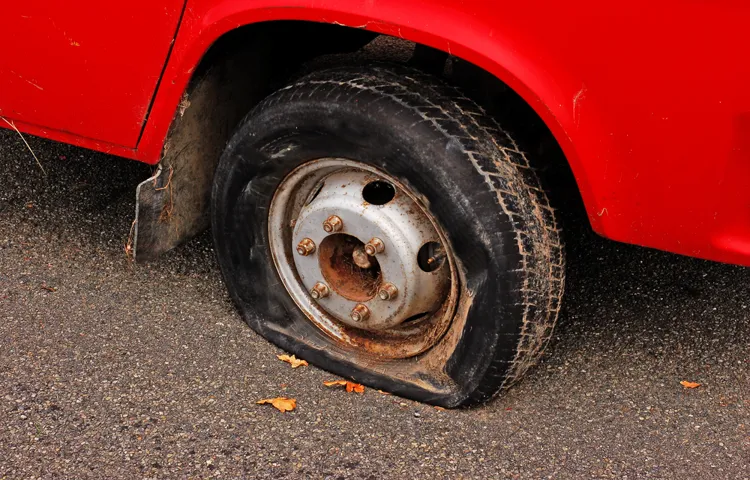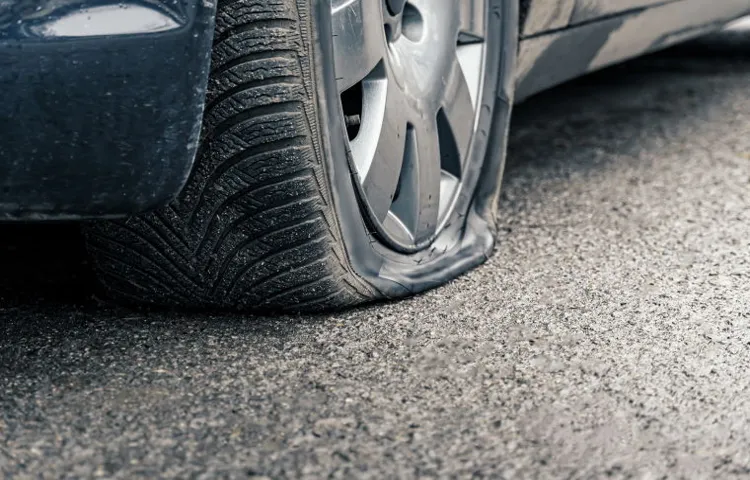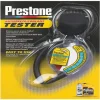Have you ever wondered how to tell if your tire is flat and how to deal with it? Checking your tires regularly may sound like an easy task, but many drivers neglect this critical aspect of vehicle maintenance. A flat tire is not only frustrating, but it can also be a hazard on the road. Knowing the signs of a flat tire and how to handle it can prevent future car troubles and keep you safe on the road.
So, let’s dive into the various indications of a flat tire and what to do if you encounter one while driving.
Visual Inspection
Knowing if a tire is flat is important for the safety of your vehicle and passengers. An easy way to tell is through a visual inspection of the tire. Start by looking at the tire’s sidewall for any signs of damage, such as cuts, bulges, or punctures.
Then, check the tire’s tread depth using a penny or a quarter. Insert the coin into the grooves with Lincoln’s head facing down. If you can see the top of his head, the tire is worn and needs to be replaced.
Also, observe the tire’s overall shape. If one part of the tire looks noticeably lower than the rest, it could be a sign of a flat tire. Furthermore, remember to check the tire pressure regularly using a tire pressure gauge.
Any significant drop in pressure could indicate a flat or leaking tire. By staying vigilant and performing visual inspections regularly, you can keep your vehicle and passengers safe on the road.
Check for Any Visible Damage on the Tire
When it comes to maintaining your car’s overall safety and performance, checking the state of your tires should never be overlooked. A simple visual inspection can help you spot any visible damage that may affect your tire’s function and ultimately, your driving experience. Look out for any signs of physical damage, such as cuts, cracks, bulges, and punctures.
These can be caused by various factors, like hitting a curb or a pothole, or from regular wear and tear. Tire damage, regardless of how minor it may seem, can have serious consequences. It can cause your tires to deflate or burst unexpectedly, impairing your ability to control your vehicle.
So, pay attention to your tires and check them regularly. Ensure that they are in good condition and replace them whenever necessary. Your safety on the road depends on it!

Observe If the Tire Is Sitting Lower than Normal
If you notice that your tire is sitting lower than normal, it’s best to conduct a visual inspection. Visual inspections are important because they help to catch potential problems before they become bigger issues. When conducting a visual inspection, start by examining the tire’s tread for any signs of wear and tear.
Look for any punctures, cracks, or cuts on the tire’s surface and sidewall as well. These could be indications of damage or a slow leak in the tire. Another important aspect to check is the tire’s pressure.
Low pressure in the tire can cause it to sit lower than normal, so it’s important to ensure that the pressure is within the recommended range. Checking tire pressure is a simple process that can be done with a pressure gauge. By conducting regular visual inspections, you can keep your tires in good condition and ensure that you’re driving safely on the road.
Physical Test
Have you ever come out to your car and wondered if your tire is flat? The good news is, it’s pretty easy to tell! The first thing you can do is to visually inspect the tire. If it looks noticeably lower than the others or appears to be bulging, it’s probably flat. Another way to test is to use a tire pressure gauge.
Simply unscrew the valve cap on the tire and press the gauge onto the valve stem. If the reading is significantly below the recommended PSI for your vehicle, your tire is likely flat. Alternatively, you can lightly kick the tire to see if it feels soft and flat.
If you’re still unsure, it’s always better to err on the side of caution and take your car to a professional to get it checked out. Remember, driving on a flat tire can be dangerous and cause further damage to your car.
Press Down on the Tire
If you want to test the condition of your tire, try pressing down on it. This physical test can give you a good idea of the tire’s air pressure and overall health. When pressing down, you should feel a firm resistance.
If the tire feels too soft or spongy, it may be underinflated, and you should add air to reach the proper pressure. Additionally, if you detect any bulges or deformities on the tire’s surface, it could mean that the sidewall is damaged, and you should replace the tire as soon as possible. Don’t underestimate the importance of a healthy tire for your safety and driving experience.
By conducting simple checks like this one, you can avoid potential accidents and save yourself some cash in the long run.
Use a Tire Pressure Gauge to Check the Pressure
Checking the tire pressure on your vehicle is a crucial factor in ensuring your safety while on the road. One way to physically test the tire pressure is by using a tire pressure gauge. This tool is affordable and easy to use, giving you an accurate reading of the air pressure in your tires within seconds.
It should be noted that checking the tire pressure regularly is crucial, as underinflated or overinflated tires can lead to handling issues, decreased fuel efficiency, and even tire blowouts. By using a tire pressure gauge, you can easily perform this vital check, and ensure that your vehicle is operating at its best. Simply remove the valve cap, attach the gauge to the valve stem, and read the pressure displayed.
It’s important to check your tire pressure when the tires are cold, as excessive driving can heat up the tires, leading to inaccurate readings. Regularly checking your tire pressure can save you money on repairs and keep you safe on the road.
Listen for Unusual Noises While Driving
When it comes to properly maintaining your vehicle, one of the most important things you can do is to pay attention to any unusual noises while driving. These noises can often be a telltale sign that something is wrong with your vehicle, and ignoring them can lead to more serious issues down the line. Some common noises to listen for include squeaking or grinding sounds from the brakes, knocking or tapping noises from the engine, and rattling or shaking sounds from the suspension.
Performing a physical test by taking your car out for a drive and paying attention to any unusual noises can help you catch these issues early on and prevent costly repairs in the future. So, the next time you hit the road, make sure to listen closely for any strange sounds and be proactive about addressing them as soon as possible.
Other Factors to Consider
If you suspect that your tire is flat, there are a few other factors to consider before coming to a firm conclusion. One telltale sign of a flat tire is visibly deflated or sagging appearance, but there are other clues to watch out for as well. When you’re driving, take note of any unusual vibrations or thumping sounds, which could be caused by a flat tire.
Additionally, if you find that your vehicle is pulling to one side or the other, it could be due to a flat tire on the affected side. Of course, the best way to confirm whether or not your tire is flat is to use a tire pressure gauge to check the air pressure levels. By doing so, you’ll be able to determine if your tire is underinflated or if there’s another issue at play.
Remember, it’s important to catch tire issues as early as possible in order to avoid serious safety hazards while on the road.
Check for Any Signs of Wear and Tear on the Tread
When it comes to checking your tire’s overall condition, there are a few other factors to keep in mind besides the tread. One important aspect is the tire’s age. Even if your tires appear to be in good condition, their age can affect their performance and safety on the road.
As a general rule, it’s recommended to replace tires that are more than six years old, even if they don’t show any visible signs of wear and tear. Another factor to consider is your driving habits. If you frequently drive on rough terrain or in extreme weather conditions, your tires may wear down faster than average.
Additionally, it’s important to check your tire’s pressure regularly, as underinflated or overinflated tires can affect fuel efficiency and your overall driving experience. By taking these factors into account, you’ll be able to keep your tires in top condition and ensure a safe and comfortable driving experience for you and your passengers.
Regularly Perform Maintenance on Your Tires
When it comes to tire maintenance, it’s not just about checking tire pressure and tread depth. Other factors can affect your tires’ health and performance, such as wheel alignment, balancing, and rotation. Wheel alignment can greatly impact tire wear and handling, so it’s essential to have it checked regularly by a professional.
Balancing ensures that weight is distributed evenly across the tire, preventing vibration and uneven wear. And rotating your tires every 5,000-7,000 miles promotes even wear and extends their lifespan. Neglecting these maintenance tasks can result in premature tire wear and unsafe driving conditions.
So, the next time you take your car in for an oil change, make sure to ask your mechanic to check your tire alignment, balance, and rotation. Your tires will thank you!
Conclusion
If you want to know if your tire is flat, there’s no need to call in Sherlock Holmes to solve the mystery. Simply keep an eye out for telltale signs such as a low tire pressure, a feeling of sluggishness when driving, or a flat-out (pun intended) deflated tire. And remember, if you ever find yourself in a sticky situation, don’t be afraid to ask for help from a trusted mechanic or a friendly neighborhood tire repair shop.
Because when it comes to our wheels, it’s always better to play it safe than sorry.”
FAQs
What are the signs of a flat tire?
Signs of a flat tire include the tire appearing visibly lower, a thumping sound while driving, difficulty in steering, and the vehicle slowly pulling to one side.
Can a tire go flat without a puncture?
Yes, a tire can go flat without a puncture due to factors such as a damaged valve stem, corroded wheel, or a leak in the tire’s bead seal.
How do I check if my tire is flat?
You can visually inspect your tire, check the tire pressure with a gauge, or use a penny to check the tread depth.
How long can I drive on a flat tire?
You should not drive on a flat tire at all, as it can cause further damage to your tire and vehicle. It’s best to get the tire repaired or replaced as soon as possible.
Can I repair a flat tire on my own?
It’s possible to repair a flat tire on your own with a tire repair kit, but it’s recommended to have a professional handle tire repairs to ensure they’re done correctly and safely.
How often should I check my tire pressure?
It’s recommended to check your tire pressure at least once a month, or before long trips or extreme weather conditions.
How can I prevent flat tires?
You can prevent flat tires by regularly checking your tire pressure, avoiding potholes and debris on the road, and maintaining proper tire maintenance such as rotation and balancing.




